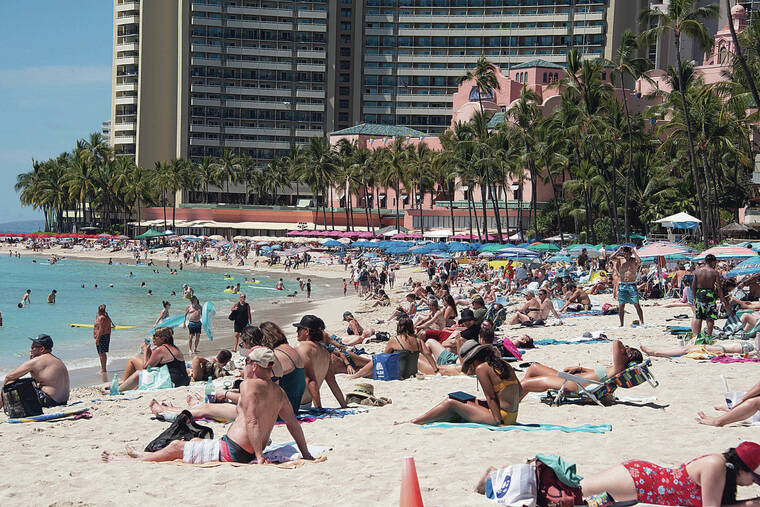Visitor spending in Hawaii is soaring, though arrivals have continued to lag behind pre-pandemic counts and could see further slowdowns given the possibility of a U.S. recession and ongoing global economic challenges.
Nearly 829,700 visitors came to Hawaii in August, down more than 10% from August 2019, according to preliminary visitor statistics released Thursday by the state Department of Business, Economic Development and Tourism. Visitor spending in August topped $1.7 billion, adding up to an increase of 13.8% over August 2019. The average per-person-per day spending was $227, up 18.6% from
August 2019.
Year-to-date figures track a pattern of fewer visitors spending more. Nearly
6.2 million visitors came
to Hawaii through the first eight months of 2022, marking a 12.9% decrease from the same period in 2019. However, total visitor spending through August increased by 6.8% to almost $12.9 billion.
Growing the visitor industry through spending rather than arrivals aligns with a key aim of Hawaii’s regenerative tourism model. On the flip side, however, inflation and higher costs are decreasing the value of the
dollar over time. And a
U.S. recession could cause some contraction at a time when counts of higher-
spending international visitors haven’t fully recovered from pandemic-related downturns.
While domestic visitor
arrivals in August exceeded the August 2019 count by more than 10%, international visitor arrivals remained well below the August 2019 tally. A total of 28,384 visitors from Japan came to
Hawaii by air in August.
Normally the state’s largest source market for international visitors, arrivals from Japan were down 82.3% from August 2019.
According to DBEDT’s latest projection, Hawaii will see some 9.2 million visitors in 2022, representing 88.5% of the total visitor count in 2019, while generating
$2.2 billion in state tax revenue and supporting 195,000 jobs.
DBEDT Director Mike McCartney said in a statement that Hawaii is on pace for a full recovery in 2025, with the stepped-up return of international visitors.
The University of Hawaii Economic Research Organization said in its most recent forecast that while the U.S. might enter into a recession in 2023, Hawaii could escape an outright contraction in economic activity, assuming that Japanese visitors return to 50% of their 2019 arrivals volume during 2023’s first quarter.
Eric Takahata, managing director for Hawaii Tourism Japan, Hawaii Tourism Authority’s Japan marketing contractor, described that forecast as “ambitious.”
Earlier this month the Japanese government eased border controls by eliminating requirements for pre-departure COVID-19 tests for travelers who have received at least three vaccine doses. However, Takahata said this development and others will not completely overcome headwinds from an unfavorable exchange rate and skyrocketing fuel surcharges, which are up to about $700 per person per ticket.
“Before you pay for any part of your air ticket, a family of four is looking at $2,800 in fuel surcharges alone,” he said, noting that the charge had been under $200 before the “Russia-
Ukraine situation.”
Kekoa McClellan, spokesperson for the American Hotel and Lodging Association, said there are signs that the mainland market, which carried Hawaii through the pandemic, is cooling rapidly and that international arrivals will not be robust in this year’s fourth quarter or maybe even in the first or second quarter of 2023.
Some Hawaii hotels have seen a drop in arrivals and some near-term cancellations, along with price contractions, McClellan said. Costs also have escalated, he said.
“If you think that your electric bill is bigger as a result of certain changes to statewide policy, imagine what that looks like at a 400-room hotel,” he said. “Our hotels also are seeing higher labor costs. They are offering better-paying jobs than at any time in the history of the hotel business.”
Mufi Hannemann, president and CEO of the Hawaii Lodging &Tourism Association, said the economic uncertainty and its impact on tourism are why it’s important that the HTA find a way to execute a new U.S. tourism contract and end an ongoing procurement dispute.
In June, HTA selected the Council for Native Hawaiian Advancement for a multiyear U.S. tourism award worth more than $34 million during the first two years. However, HTA and CNHA cannot move forward on a contract until HTA rules on a protest from the Hawaii Visitors and Convention
Bureau, the entity that was originally selected to retain the U.S. tourism award in a December deal.
“I feel like they are taking too long to make the decision,” Hannemann said. “There’s a place for CNHA and HVCB. Right now we are at an impasse. Not only is the traveling public confused, but our travel partners are confused. This is not the time to have the largest marketing contract, the U.S. contract, unresolved.”
A three-month extension on the U.S. contract expired Wednesday without an official announcement about HTA’s path forward.

